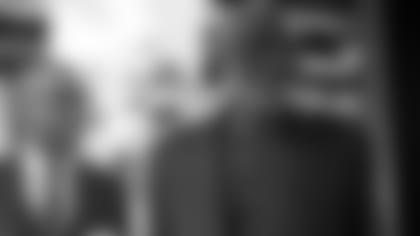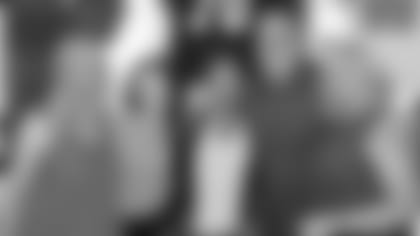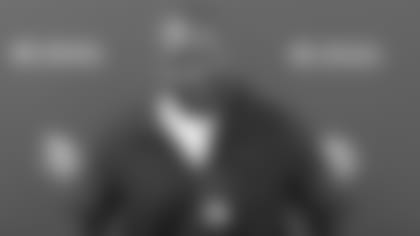EAGAN, Minn. — Vikings Legends who have left a lasting legacy on the franchise, Minnesota and beyond were on-hand Friday for the unveiling of the Vikings Museum.
The 14,000-square-foot facility features hundreds of artifacts and enables timelessness to intersect with technology in interactive displays.
Vikings members of the Pro Football Hall of Fame, including 2018 enshrinee Randy Moss, are featured via vertical kiosks that tell the stories of 14 players in words, pictures and video clips. There are founding documents, as well as audio clips from the first Vikings training camp in Bemidji in 1961 and video highlights of the greatest plays in franchise history, including the Minneapolis Miracle.
Vikings Chief Operating Officer Kevin Warren said the Vikings Museum is a reinforcement of the commitment that the Wilf family has made to embrace the history of the franchise since acquiring the club in 2005. The Wilf, Mandelbaum and Landis families, Warren said, noted that "very few owners really took the time to focus on the history" of their respective franchises.
"What a museum says is that it's a space that holds special things, so this is our Smithsonian," Warren said. "People are going to come from around the world, but today we wanted [to host] you all as another way to say thank you.
"Today is about every person who has played for the Minnesota Vikings, their significant others, spouses, parents, grandparents, children and grandchildren, because without the players and families who sacrificed for many, many years for the betterment of the game of professional football and primarily the Minnesota Vikings, we wouldn't be standing here," Warren said. "So many times, people are so eager to look forward in life, which we are so eager to do, but fortunately I had two great parents and some great grandparents who taught me to always look back."
Warren said he hoped that the Vikings Legends would feel appreciated for their contributions to the history of the team.
Vikings Executive Director of Brand & Creative Erin Swartz, who oversaw the project, said opening the Vikings Museum fulfilled a long-term goal. She envisions the space at the team's new headquarters, Twin Cities Orthopedics Performance Center, as one that will continue to evolve.
"It has long been a goal of the Minnesota Vikings to create a space that could really tell the comprehensive history of this franchise and especially a priority of the Wilf family, but we knew that we had to do it right," Swartz said. "We had to find a space that was big enough to tell these amazing stories. We had to find a space that was public so our fans could come all year round and be engrossed in the stories with us."
Some of the most personal artifacts are in comprehensive displays that chronicle Hall of Fame Head Coach Bud Grant, who led the Vikings for 18 seasons, and running back Tommy Mason, the first player ever selected by the team in an NFL Draft and Minnesota's first All-Pro.
Grant, who was among the distinguished guests, became emotional when he saw a picture of himself with Sid Hartman from Grant's 1994 enshrinement ceremony. Grant loaned relics that never made it into any of his famed garage sales for display in the Vikings Museum and said he enjoyed viewing the other exhibits.
"Whoever the curators are have done a great job," Grant said. "They've highlighted all the Vikings important moments and personnel and history — it's all there. So if you're a Vikings fan, you don't want to miss it."
Mason, who was selected No. 1 overall in the 1960 NFL Draft, passed away at age 75 on Jan. 22, 2015, but his vibrant story is able to be told through a collection on loan from his wife, Karen Mason.
The Mason artifacts range from Boy Scouts merit badges to a photo of Mason with his pet monkey, which he named "Dutch" in honor of first Vikings Head Coach Norm Van Brocklin (known as "The Dutchman"). They also include awards and all-star game appearance mementos, as well as his No. 20 jersey that is on loan from Tom and John Aldritt and their families.
"Tommy was so humble," Karen said. "I was a little nervous about doing this because he was always so soft-spoken about his accomplishments, but I did the right thing. I'm glad I did it. I think you all did a good job."
Ultimately, Karen decided that the display would provide an opportunity "for everybody to really see who he was, because he was such a darling man."
"As tough a competitor as he was, he was the nicest person I've ever met," she said. "He had such a fun side, and I think these artifacts really show that, and it does him such an honor."
Three members of the Purple People Eaters — Alan Page, Carl Eller and Jim Marshall — shared their initial impressions of the Vikings Museum.

Alan Page
Alan Page was joined by his wife, Diane; son, Justin; and two grandchildren who saw old photos and video highlights of their grandfather play in his Hall of Fame kiosk.
Page's No. 88 jersey from the 1969 season has been "Frozen in Time" in an "ice column" that also features his helmet with its distinctive face mask and a trading card that celebrated his post-football position on the Minnesota Supreme Court.
The Page family has loaned the museum his 1971 NFL MVP trophy, when Page became the first defensive player to win the award.
" 'Long Island Touchdown Club,' " Page read from the plaque on the hefty trophy.
"It's hard for me to describe because in my view, independent of me, it's a majestic piece. It captures, I think, what is great about the game of football. It projects strength but also there's a warmth to it; [it's] not just a cold piece of metal. It is quite an honor for me to have been selected, not something that I ever anticipated or thought about, and to see it here in the museum, it's special.
"As you know, I'm generally not one to look in the rearview mirror, but as Kevin said, there are times when it's important to look back," Page added.
Page hadn't made it very far into the museum before he was asked to reflect on the space, but he did say, "Well done. It's really impressive. Of course, I haven't gotten past my own exhibit, so easy for me to say."

Carl Eller
Eller stood in front of his Hall of Fame kiosk and placed his right hand into a custom-formed handprint on a silver football – a perfect fit. He was greeted in response by a picture of himself from 1964, fresh off his time with the Golden Gophers and into the fledgling days of the franchise.
"That's my rookie year," he reflected.
Eller and his wife, Molly, turned the corner and saw the display dedicated to Metropolitan Stadium, where "Moose" roamed from 1964-78. He had a chuckle when he viewed the sword, shield, vest and horn that original Vikings mascot Hub Meeds made famous.
Eller walked past a display about the history of training camps and the Purple People Eaters before sitting to view the "Decade of Dominance" display, where his jersey joins those of the 10 other Vikings players who were on the roster for each of the team's four trips to Super Bowls.
"I'm actually amazed. I want to come back and spend more time here," Eller said. "It's a fantastic gathering of memories for me and a significant contribution to the area."
"I've had a few memories come back," Eller said. "I think my quote [about training camp] is the idea that you were going to prepare for something that was coming up and you had to work really hard for it, but the goal was to get to the Super Bowl.
"That was exciting to have that in your mind and in your thoughts, that you really had something to work for and come back for," Eller continued. "It was a tremendous dedication and natural sacrifice to keep that goal. That's what I think was our great achievement, to be that dominant and part of a great team that was as committed and dedicated as we were for that time. That's a lot of dedication from a great number of people."

Jim Marshall
Marshall, an original Viking who didn't miss a game from 1961-79, was unable to attend Friday's event but privately toured the space Sunday with his wife, Sue Landwehr; daughters, Angie Marshall Moore and Jimi Belanger; and granddaughter, Madison Belanger.
Much like the franchise, Marshall is intertwined throughout the museum.
He also is in the "Frozen in Time" display for the six jerseys that have been retired in franchise history, along with Page, Fran Tarkenton, Mick Tingelhoff, Cris Carter and Korey Stringer.
Marshall's No. 70 is accompanied by his helmet, hand pads and an extremely rare game ball from 1963 that was hand-painted by original equipment manager Jim "Stubby" Eason.
The equipment bag of the ironman who started all 270 regular-season games he played, is featured in the "Decade of Dominance," and his locker from Metropolitan Stadium is an area that pays homage to the Vikings first game-day home.
"I think it's a great portrayal of Minnesota football up to this point," Marshall said. "Just a fantastic display of all of the talent that's come through Minnesota, and I'm very proud to see this. It's just fantastic."
Marshall, a captain who generally doled out the game balls, received one for his final home game, a 10-3 victory against Buffalo. That ball from Dec. 9, 1979, is one of 54 balls that are accompanied by an interactive screen that tells the story of each football.
He, Page, Eller and Grant also are in the digital projection book that features the 50 Greatest Vikings. The book blends text, photos and highlights on a spread that was uniquely created for 50 who were named in 2010 as part of the franchise's 50th season celebration.
Marshall's highlight real includes walloping Jim Brown of the Cleveland Browns, for whom Marshall played in 1960.
"Eat that!" Marshall said as he watched himself take down Brown.
"It's just all great," Marshall added. "To see a lot of this stuff brings back great memories."














